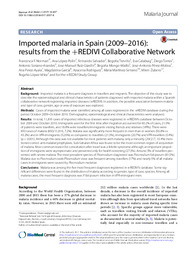Título :
Imported malaria in Spain (2009–2016): results from the +REDIVI Collaborative Network |
Autor :
Torrús, Diego 
Norman, Francesca F 
López-Polín, Ana
Salvador, Fernando 
Treviño Maruri, Begoña 
Calabuig, Eva 
Soriano-Arandes, Antoni 
Ruíz Giardín, José Manuel
Monge-Maillo, Begoña
Pérez Molina, José Antonio
Perez-Ayala, Ana 
García, Magdalena
Rodríguez, Azucena
Martínez Serrano, María 
Zubero, Miren
López-Vélez, Rogelio  |
Editor :
BioMed Central |
Departamento:
Departamentos de la UMH::Agroquímica y Medio Ambiente |
Fecha de publicación:
2017-10 |
URI :
https://hdl.handle.net/11000/35438 |
Resumen :
Background: Imported malaria is a frequent diagnosis in travellers and migrants. The objective of this study was to
describe the epidemiological and clinical characteristics of patients diagnosed with imported malaria within a Spanish
collaborative network registering imported diseases (+REDIVI). In addition, the possible association between malaria
and type of case, gender, age or area of exposure was explored.
Methods: Cases of imported malaria were identified among all cases registered in the +REDIVI database during the
period October 2009–October 2016. Demographic, epidemiological and clinical characteristics were analysed.
Results: In total, 11,816 cases of imported infectious diseases were registered in +REDIVI’s database between October
2009 and October 2016. Immigrants seen for the first time after migration accounted for 60.2% of cases, 21.0%
of patients were travellers, and 18.8% were travellers/immigrants visiting friends and relatives (VFRs). There were
850 cases of malaria (850/11,816, 7.2%). Malaria was significantly more frequent in men than in women (56.8% vs
43.2%) and in VFR-immigrants (52.6%) as compared to travellers (21.3%), immigrants (20.7%) and VFR-travellers (5.4%)
(p < 0.001). Although this data was not available for most patients with malaria, only a minority (29/217, 13.4%) mentioned
correct anti-malarial prophylaxis. Sub-Saharan Africa was found to be the most common region of acquisition
of malaria. Most common reason for consultation after travel was a febrile syndrome although an important proportion
of immigrants were asymptomatic and presented only for health screening (27.3%). Around 5% of travellers presented
with severe malaria. The most prevalent species of Plasmodium diagnosed was Plasmodium falciparum (81.5%).
Malaria due to Plasmodium ovale/Plasmodium vivax was frequent among travellers (17%) and nearly 5% of all malaria
cases in immigrants were caused by Plasmodium malariae.
Conclusions: Malaria was among the five most frequent diagnoses registered in +REDIVI’s database. Some significant
differences were found in the distribution of malaria according to gender, type of case, species. Among all
malaria cases, the most frequent diagnosis was P. falciparum infection in VFR-immigrant men.
|
Tipo de documento :
info:eu-repo/semantics/article |
Derechos de acceso:
info:eu-repo/semantics/openAccess
Attribution-NonCommercial-NoDerivatives 4.0 Internacional |
DOI :
https://doi.org/10.1186/s12936-017-2057-8 |
Publicado en:
Malar J 16, 407 (2017) |
Aparece en las colecciones:
Artículos Agroquímica y Medio Ambiente
|
 La licencia se describe como: Atribución-NonComercial-NoDerivada 4.0 Internacional.
La licencia se describe como: Atribución-NonComercial-NoDerivada 4.0 Internacional.
.png)
